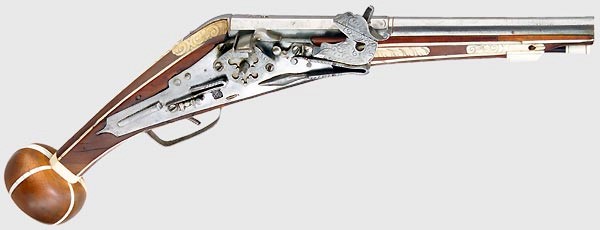This 18th-century Land Pattern flintlock pistol sold for £1600 in our November 2019 Fine Art auction.
The flintlock mechanism, as the everyday person would recognise it, was invented by Marin le Bourgeois in 1610. Other types of similar mechanisms predated it, but le Bourgeois’ design would prove so effective it would supersede all other designs.
Precursors to the flintlock were in use throughout the 16th and 17th-century, but they weren’t technically ‘true’ flintlocks. The casual observer might not recognise the various, often subtle differences, but the wheellock, snaplock, snaphaunce, doglock and miquelet all used the same basic principal; each type involved a spark produced through friction to set off the gun, and built upon improvements from previous designs, with their own distinct features.

A wheellock pistol, circa 1580.
The first, and perhaps most complex, was the wheellock mechanism. It was the first design to replace the matchlock, which had required the use of a slow-burning match cord to set off the charge.
This new design, dated to around 1500, involved an internal spring-driven wheel which was exposed at the base of the flash pan and fixed on a horizontal shaft. The hammer, or ‘dog’ in this instance, is not actually the part that moves; instead the dog is merely placed in position by hand, pressing down on the pan when ready to fire. Instead of a flint, the dog holds a piece of iron pyrites.
The pan has a sliding lid to protect the powder until ready to fire, either operated manually, or sometimes driven by the firing mechanism. With the dog in position and the pan opened, the trigger is pulled, and the wheel spins against the pyrites, generating the spark.
It’s roughly akin to how a lighter works. Reloading the gun would necessitate the use of a wrench being slotted onto the exposed squared end of the shaft, holding the wheel in place, to wind the wheel back again and lock it in the tensioned position.

A closeup of a snaplock mechanism. Image credit: veryimportantlot.com.
Following on from the wheellock was the snaplock, which introduced the method of flint striking steel, with the hammer (known at this point as the ‘cock’) being the spring-driven, moving part. The automatically opening pan cover was, however, strangely absent from this design.

This snaphaunce rifle realised a price of £110 in our July 2021 Fine Art auction.
The snaphaunce mechanism brought in the automatically opening pan cover as a standard feature. When the trigger was pulled, the cover would spring open with the forward motion of the hammer, at exactly the right moment to receive the spark from the flint.

A closeup of a doglock mechanism. Image credit: militaryheritage.com.
Another further improvement, the doglock allowed for the hammer to be locked at half-cock, using an external catch, known as the ‘dog’ (not to be confused with the ‘dog’ as associated with the wheellock!). It also did away with the sliding pan cover. Instead, the steel evolved to serve as both a striking surface for the flint and as a cover for the pan in one single piece, becoming known as the ‘frizzen’. It was an elegant solution.

The miquelet was basically the same as the doglock, with just the subtle alteration of using internal horizontal bars, or ‘sears’, performing as the half-cock and full cock catches.
The true flintlock was the culmination of all this development, incorporating the spring-loaded hammer and the frizzen pioneered by the earlier designs. The ability to half-cock the hammer was also improved with an internal catch, rather than the external dog or the use of sears, to hold the hammer in place.

This distinctive pair of Scottish Highland Murdoch pistols sold for £800 in our September 2020 auction.
Flintlocks are immensely popular. One could speculate as to the influence of a certain movie franchise – but apart from this, many types of flintlock were very decorative. This was usually indicative of the status and wealth of the owner.
Balkan flintlocks, for example, are known for amazing carvings and inlays. Another iconic design is the all-metal Scottish Murdoch pistol, designed specifically with Highlanders in mind. Flintlock weapons from the Middle East also had a unique and distinctive style. The Afghan Jezail rifle is a classic example, often bespangled in mother-of-pearl. Naturally, such decorative firearms can be highly desirable.

A jezail musket. Image credit: andersonandgarland.com.
By the first half of the 19th-century, an even more reliable mechanism had begun to be introduced. Often mistaken for a flintlock, yet doing away completely with the use of a flint and the need for a flash pan, the percussion lock spelled the end of flint-using weapons in mainstream use.
How to Buy or Sell Flintlocks at Auction
Here at Potteries Auctions, we run regular auctions and attract buyers and sellers from all over the world. We’re based in the heart of the Staffordshire Potteries with two salerooms; the Silverdale Saleroom and the Cobridge Saleroom, so we’re best placed to offer valuations and advice. This is because our experts can assess your vintage firearms for authenticity and market value.
If you’ve got flintlocks or other militaria to sell, we can identify and provide valuations to tell you how much it’s worth. Please get in touch with usto discuss how we can help you or request a call back if you are looking for an expert evaluation and are seeking to sell your items or add to your collection.
Email Valuations
If you can’t come in and see us in person but would like to submit firearm or militaria items for auction or valuation, send us an email to enquiries@potteriesauctions.com with details and a photograph (eg make, model, model number, measurements, condition) and one of our experts will provide information and auction estimates. Alternatively, give us a call on 01782 638100 to arrange an appointment.
